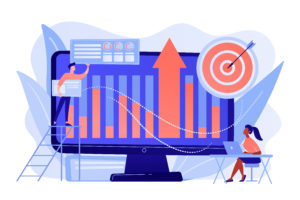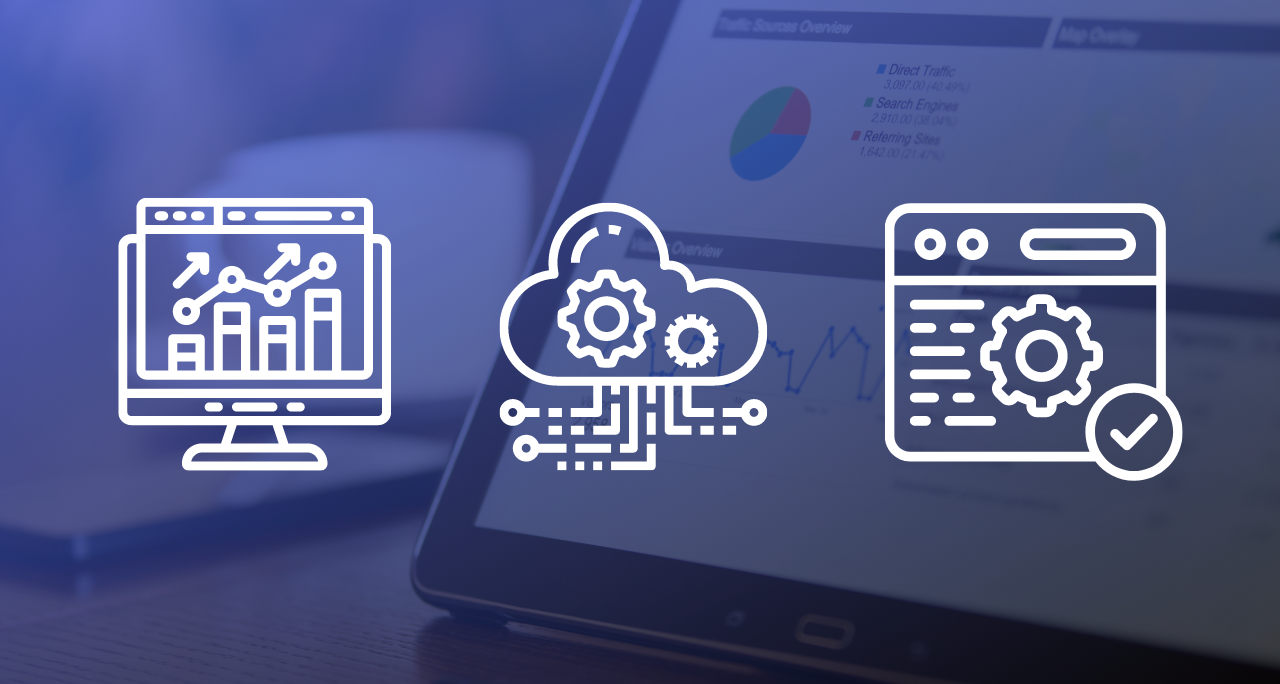Updated in May, 2022
You’ve gotten your SaaS business up and running. After the whole launch process is complete, one of the most natural questions that comes to mind is: How do I successfully scale my SaaS company? It’s fair to say that the ultimate goal of any founder is to see their company grow, and – even more importantly – grow fast. But the trick here is that there is no exact recipe for success.
What does scaling a business, whether it’s SaaS or not, mean?
Scaling a SaaS business means looking for ways to generate more profit without incurring significant costs. This can be achieved by entering new markets, gaining more customers, or adopting innovative technologies, such as investing in new software, for example.
No matter whether they are VC-backed or bootstrapped, all SaaS businesses aim to achieve a Drift or Slack kind of growth. However, there is no easy way to scale a SaaS business, and the “overnight success” formula is just a myth. If you embarked on this journey thinking there’s a silver bullet, you will be disappointed. Scaling takes time, patience, some mistakes, and a lot of resources.
One of the popular mistakes SaaS startups make is allocating resources the wrong way. Hoping they will achieve exponential growth and success instantly, they get ready for the moment they will “go viral,” and invest the bulk of their resources in preparation for that moment which may never happen, or at least not when it’s planned. And if it does happen, it rarely meets the expectations of the team. Let’s not forget the SaaS industry is very competitive; it’s getting more and more difficult to make yourself heard.
The first thing that you must do when planning your SaaS growth is to develop a strong scaling strategy. We have created a checklist with ten best practices that might just come in handy. Start implementing them one by one, and you’ll be off to a great start.

1. Rethink your sales strategy
Take a closer look at your sales funnel and invest in prospecting and hiring the right salespeople. You can’t build and grow a company without making smart hires. However, you should invest aggressively to expand your sales force only once you have found a successful sales model for your business.
Keep in mind that even though you may have a large and effective sales team, it won’t mean much if your sales model is not suitable for your SaaS product. So, it’s crucial to first inspect and analyze different models and choose the best one for your business.
There are three SaaS sales models you can use for your business, each of which takes into account what type of product you are selling and your target market:
- Enterprise Sales Model – This model is the most complex one and is best suited for big companies. Enterprise companies usually need to engage both internal and external sales teams, along with the marketing department, in order to form new relationships with potential customers, close, and support clients along their purchasing process. This model implies strong customer service that stands in the form of technical support, and on-site problem-solving. Because of its complexity, the enterprise model has quite a high degree of risks and costs. However, it allows companies to acquire more customers and retain them for a longer period, so in most cases the value-added outweighs the cost.
- Customer Self-serve Model – This model doesn’t require any sales activity, but on the other hand, the marketing team takes full responsibility for generating the revenue. This is typically done by raising product awareness, publishing content that targets the right audience, setting up automated sequences, streamlining the sign-up process, and generating new users. Your website and content initiatives are the main pillars of the sales process, as they guide the potential customers through the process and encourage them to sign up on their own for your product.
- Transactional Sales Model – Typically, customers are wary of spending money on a product without having some interaction with the company beforehand. So, in order to build a strong relationship with your clients, your marketing and sales departments should team up to focus on lead generation and support the customer’s purchase process with content marketing techniques and strategies. The transactional model is a blended one, where companies use aspects from a sales-led approach in combination with a product-led approach.
If you hire too many salespeople too soon, your cash flow will be affected.
On the other hand, if you don’t hire sufficient numbers of people at the right time, your Monthly Recurring Revenue (MRR) growth rate will decline due to churn (and not enough new customers to make up for the churn). There is a delicate balance between growth and cost that you need to achieve. That is why a repeatable, scalable sales model is essential to begin with.
Another question you might have: “How do I close more deals?” Besides hiring more people, you should optimize your sales strategy and tactics, automate some parts of the process to require less time and effort from salespeople, invest in trainings for your team, and hire effective management. Don’t forget to adjust sales quotas and gross margin percentages accordingly. Once you have those elements in place, you’ll be on your way to success.

2. Fuel your content marketing efforts
Many SaaS companies don’t have content marketing embedded in their culture. And it’s true, it can take a lot of time and effort to create a content plan, develop relevant pieces targeted to a specific audience, all while monitoring what the industry is saying.
Bonus: Check out these tips on how to successfully use content marketing to boost your lead generation and client retention!
Before you start writing your content, think about your audience: who are you producing the content pieces for? What are their needs and how can they benefit from your content? By creating a buyer persona profile for your audience, it will allow you to write targeted content that will address the issues your customers are facing. This way, you will be able to predict the questions that your audience has, understand their pain points and, ultimately, be able to respond to their direct questions.
Here’s a quick tip: try to use as many real-life examples as possible in your content to illustrate the similarities between customers in various locations and demographics. This way, your buyers can identify with your content much more easily.
Invest in thought leadership content, as it will contribute to brand awareness and trust. A good content strategy can help you generate leads quickly and at lower costs than if you just invested in paid advertising, thus keeping CAC down. This strategy is a long-term one, but if you invest enough time and thought into the process, you will begin to gather the ripe crops sooner than you might expect.
Once you have your content published and ready to go, do some research and find out which websites and platforms your audience visits and share your content there as well. This is a great way to make your brand much more visible and attract potential new buyers.
The other side of the profitability equation is your Customers’ Lifetime Value (CLTV). To ensure growth for your SaaS business, you should always aim to have a Lifetime Value (CLTV) that is higher than 3x the Customer Acquisition Cost. You can grow CLTV through well-thought-out marketing mechanisms like upsells, cross-sells, upgrades, or even downgrades (to minimize churn), and by surprising and satisfying your customers at every touchpoint.

3. Retarget your visitors
An important aspect that should not be overlooked in your SaaS growth strategy is retargeting visitors, which is one of the key lead nurturing tactics. Your website visitors don’t often convert on their first visit. Some of them choose to do some further research on the product or service that they want to purchase, look for other options, and sometimes they might put off their decision for a significant length of time. By implementing a good retargeting campaign, you can stay at the top of your visitors’ minds, have them revisit your website, and eventually convert them into paying customers.
In order to reap the best results from remarketing campaigns, you need to build a strong strategy and make remarketing not just part of your marketing game but a recurring cycle. The secret to remarketing is to create smarter campaigns and use the right channels to target your customers based on their end goal.
To create a strong and effective retargeting campaign, you have to invest in building brand awareness as well as strong conversion pages that illustrate powerful value propositions. Once you have all of these set up, your campaign should pursue the messages and pain points that you have addressed on your website.

4. Have you thought about growth hacking?
You knew this one had to come up at one point or another. Growth hacking is not only a buzzword but also a proven way to help a SaaS business reach success very quickly.
Growth hacking implies developing marketing strategies that come as an extension of your product, and when done correctly, it results in rapid growth at minimal cost, rather than using slow marketing techniques. It’s about trying out a variety of creative tactics that can help you grow your startup or established business.
Here are a couple of growth hacking tips that will most certainly help you scale your SaaS business:
Get your SaaS business listed on review directories
These days, customers are more likely to research your product thoroughly before testing it. And one of the primary steps they take when conducting their research is to consult reviews early on in their purchasing process, to make an informed decision. So, it’s safe to say that a crucial step in your growth hacking strategy is to list your SaaS business on some of the most popular review websites. This is a great way to build brand exposure and bring your customers to you.
Collaborate with influencers
An important aspect of your scaling strategy is to look for new ways and channels to reach potential customers. Influencer marketing is a great way to build brand awareness. Look for influencers and experts that represent thought leaders in your target market as they represent a great source of new leads. Collaborating with trusted influencers will help set your SaaS business in the limelight of your target customers, and build your brand reputation.
Before reaching out to influencers and requesting favors, we recommend following them on social media platforms, analyzing their audience, their style, and engaging with their posts regularly. This way they will start to notice your brand, and it’s the most effective way to build a relationship that you can leverage down the road. And remember, working with influencers should always be a two-way street.
Provide customers with a smooth onboarding process
When it comes to SaaS businesses, customer onboarding is one of the most crucial steps in the customer retention process. The more complicated and time-consuming the onboarding process is, the higher chance that your users will give up on your product. To get your customers to stick around and reduce churn, you need to offer them a seamless and frictionless onboarding experience that helps them succeed with your product quickly and gets them to come back for more.
A couple of SaaS onboarding tips include offering educational content and video tutorials for your product walk-throughs, providing your customers with live chat services that they can use whenever they have a question, and sending personalized and detailed messages or emails that coincide with each of the onboarding stages of your customers.
Create intuitive landing pages
As the name suggests, landing pages are the first pages that your visitors land on whenever they reach your website. They’re one of the first pieces of information that they access. Having complex landing pages on your site will most likely distract your potential customer’s attention from your product and goal. It’s imperative that your landing pages are intuitive, focused, and very narrow in their intent. Some best practices that you can use when optimizing your landing pages include removing the navigation to concentrate the visitor’s attention on a single call-to-action. Minimize the distractions by only leaving the content that drives the user toward taking the action you want them to take.
Deploying other growth hacking techniques such as launching a program to reward loyal customers, offering help in online communities such as Quora or Reddit, repurposing marketing content, or offering strategic discounts are just a few ways to get a business closer to success. You just need to pick the right approaches (depending on your business model, resources, objectives, and so on) and experiment your way to growth.

5. Keep your customers insanely happy
First, always track your churn rate and your Net Promoter Score (NPS). These metrics show how healthy the relationship between your business/product and your customers is. Companies with a customer-focused strategy have always been more successful than those focused inwards, on their product.
Always ask for feedback from your customers and show that you are genuinely interested in how they’re using your product, so you can offer them the very best version of it.
Collecting feedback from your customers as they are using your product is the most efficient and effective way to learn much-needed contextual information, which will help you down the line to shape your product roadmap. To encourage your users to share their feedback with you, try using incentives, such as discounts, coupons, or even loyalty points.
Another good opportunity to collect feedback is customer surveys and follow-up emails for the customers who have decided to leave your brand. To reduce your churn rate, it’s imperative to find out what exactly these customers needed and didn’t get from your brand. By sending them an exit survey, you can discover more insights on how to improve your product, and maybe even encourage them to stay on board.
It’s very important to understand that gathering all the feedback you can about your product is an essential step in your SaaS growth strategy, as you need to discover how to satisfy your customer’s needs and how to best optimize your product. Asking your buyers for feedback and demonstrating interest in what they have to say builds unparalleled trust and loyalty.
Keep in mind that a brand’s reputation and the reviews its products receive are some of the most important factors influencing customers’ decision to buy. They are some of the first things that your customers come in contact with when researching your brand, so they are the ultimate salesperson for your SaaS business.
Additionally, your customer success and customer support teams should be trained and empowered to properly solve any issues for those customers you’ve worked so hard to win over.

6. Build a referral program
Turning customers into advocates is the way to go if you want to scale your SaaS business. You can gain advocates with custom outreach efforts, such as a personalized video or email, or even engaging in real conversations with your clients.
Word-of-mouth has become a major source of influence when it comes to customers’ purchase decisions. This implies that having brand advocates who can vouch for your products, leave positive reviews, share their positivity about your brand, and generate buzz around you is a great SaaS growth technique.
Timing is also important: it’s better to ask for referrals after getting positive feedback from customers. If they accept, come up with a special reward for advocates. Use incentives by offering things that are both relevant to them, and at the same time, will motivate them to provide you with referrals. You can start by acknowledging your brand advocates. Then you can continue by building loyalty rewards programs, offering them discounts, or even access to exclusive products. Once they refer you to a new prospect, they can gather special points, or get special bonuses.
Customer advocacy strategies could be a great competitive advantage if you know how to leverage them. All you need to do is to approach customers with a combination of trust, respect, and goodwill that will motivate them to tell a compelling story.

7. Improve your pricing
Your pricing should be a matter of continuous improvement and optimization, so don’t treat it like something that shouldn’t be changed during your growth journey.
To find the right pricing strategy for your SaaS, feel free to experiment with the page, packages, names, and the offering. A/B testing is going to be a huge help for you in this matter. We’re not necessarily suggesting that you should increase your fees to grow the business, but rather to optimize and price your product(s) accordingly. We have put together an overview of the most common pricing strategies that you can use to determine the pricing strategy for your SaaS products:
- Cost-based pricing – This strategy involves adding up the cost to bring a product or service to market with your target profit margin that you are aiming to achieve in order to determine the price.
- Value-based pricing – By using this strategy, businesses consider the market value of the product or service they are selling as the starting point. When pricing on value, the 10x Rule is recommended, which means that the intrinsic value supplied should always be ten times its perceived cost.
- Penetration pricing –Using low or below-market pricing when launching a SaaS business is a strategy used by many companies to quickly enter the market and gain a quick advantage ahead of the competition. But beware, this strategy only works for a brief time frame, as it’s only viable if you have the necessary resources to delay profitability until you can convert upsells and cross-sells down the line.
- Premium pricing – This pricing strategy is reserved for luxury brands, as the premium pricing relies on the company’s perceived quality and brand awareness to charge above-market prices.
- Promotional pricing – With this strategy, a SaaS company sets a high initial price and slowly lowers it over time. This strategy works well in technology fields, where people are usually willing to pay for a premium plan to be among the first to adopt new technology, product, or service.

8. Conquer international markets
Selling internationally is an important milestone in the growth journey of your SaaS business. First, do some research to see which markets are worth giving a try. Then, figure out the shopping behavior of the people who live in the countries where you are planning to sell. Think about the payment methods you should offer, what shoppers are looking for when researching a product online, which support method they prefer, and so on.
To successfully expand your SaaS business in international markets, it’s important to optimize your website for the countries you are aiming to sell in. Think of localized pricing, carts, checkout experience, as well as the payment methods preferred by the countries that you are looking to expand into. In addition, it’s crucial to offer your customers a well-tailored customer experience, so you can capture their interest and loyalty.
Also, you should consider creating an international promotions calendar featuring local holidays to target. Each country has its own unique holidays that represent important opportunities to reach their buyers.
Key takeaway: you should have a “local approach” in your global selling strategy.

9. Automate your business
Another tip that can greatly improve your SaaS growth strategy is automating your business as much as possible. When owning a SaaS business, the most crucial aspect of your scaling process is time, and how you can divide your time between tasks to provide stellar services.
Try doing some research into your marketing, sales, and customer service departments to discover what processes you can automate. It can involve anything from marketing campaigns, onboarding, nurturing, to triggered notifications and churn prevention tactics. This way, you can provide your staff with time to focus on much more complicated matters.
Some software tools you can integrate into your automation process include:
- Automation tools that can help you trigger workflows for communication with your customers, as well as internal processes
- Email marketing automation tools, which trigger emails to your customers
- Sales forecasting solutions
- Project management
- Accounting and invoicing tools
- Help desk tools with automated features

10. Scale your way through omnichannel support
A great way to retain your customers is by providing them with a high-quality omnichannel support system. An omnichannel support system implies offering your customers assistance and advice across an integrated network of devices and communication channels. In this manner, the customer experience that you provide to your buyers is seamless and consistent throughout the whole process, regardless of the channel or medium they use to get in contact with your company.
The benefits of omnichannel customer support include:
- Increasing your conversion rates and customer satisfaction. By storing all the information and paths that your customers take in one place, you can easily analyze your customer journey map and better meet your customer’s needs.
- Saving time for your team and customers, as it unifies many points of contact into a single platform, allowing the information to flow from one channel to another.
- Receiving complex customer insights through channels such as social media, forums, or chats. This way, you can find out how your customer’s needs differ across different channels.
- It allows you to stand out from the competition. As omnichannel support is still a practice that not all businesses use, offering your customers innovative services will most certainly help you build your way to the top-of-mind spot of your customers.
You can build a strong omnichannel support system by developing a Knowledge Center with frequently asked questions, as well as onboarding trainings and tips on how to use your service and product. You can also use live chat tools that offer 24/7 support to your customers and even AI-powered chatbots to help you handle low-priority requests and common queries and questions. Social media platforms are also fantastic tools to provide your users with quick answers to their queries.

To summarize
Scaling a SaaS business is a matter of teamwork, making the right business decisions, and allocating resources the right way. Always keep an eye on your metrics and don’t wait too long to make adjustments.
To figure out which strategy works best for your SaaS, the key is to test them out for yourself and closely analyze your results. It takes time to discover the perfect recipe, as no business is alike, just as no customer is the same (that’s why we’re stressing out the importance of A/B testing). Once you have discovered your own flow as well as the strategies that best fit your company, you will start to see how the results work in your favor.
We wish you the best of luck on your growth journey!
Ready to take your SaaS scaling efforts up a notch? Check out this webinar to discover best practices on how to use growth hacking to unleash a sustainable growth engine.






